Increased Corn Supplies Reduce Price Prospects
Despite a 64-million-bushel reduction to 2011/12 forecast corn production this month with lower reported area, the 209-million-bushel gain in carryin over the previous forecast boosts 2011/12 corn supplies, resulting in a 30-cent-per-bushel decline in the projected farm price.
Increased US beginning stocks and increased foreign production combine to boost world coarse grain supplies 10 million tons this month.
Global coarse grain ending stocks for 2011/12 are increased six million tons this month to 156 million, mostly on higher expected corn ending stocks in the United States. US corn ending stocks are still projected to be the lowest since 1995/96, and world corn stocks remain projected at a five year low.

DOMESTIC OUTLOOK
Corn Carryout Stocks for 2010/11 Higher Than Expected
The 30 September NASS Grain Stocks report indicated 1 September US corn stocks of 1,128 million bushels, an increase of 209 million bushels from the September WASDE forecast. Still, ending stocks for 2010/11 are 580 million bushels lower than the previous year. The stocks data and nearly final data for other domestic use and trade imply a fourth quarter feed and residual use of only 448 million bushels, the lowest quarterly corn feed use going back as far as comparable data are available (1975/76). However, annual feed and residual for 2010/11, at 4.80 billion bushels, is neither unusually large nor unusually small, coming in as the 17th largest in the last 35 years even as the use of distillers dried grains has slowed the direct use of corn for feed.
Because the feed and residual category includes residual use, statistical errors in other supply and demand measures show up in the residual usage. A number of factors could contribute to the exceptionally low fourth quarter feed and residual estimate, however, all such factors are speculative and not necessarily supportable by available data. Among possible factors that could explain the lower-thanexpected fourth quarter feed and residual use would be (1) the impact of higher prices on usage, (2) early usage of new-crop 2011/12 corn, (3) tighter pipeline (in transit) supplies, and (4) higher quality of 2010-crop corn compared with 2009-crop.
Although none of these potential explanations are definitive and even together may not fully explain all of the reduction year-to-year in feed and residual disappearance during the last half of the 2010/11 marketing year, these factors do merit some discussion.
- High corn prices encourage less use and more efficient use. Cash bid prices for corn in Central Illinois were above $6 per bushel from mid-March through August, topping $7 per bushel several times over those months.
- Some new-crop corn is harvested before 1 September each year and the increase in southern corn production in recent years has allowed for more harvesting ahead of the new crop year. Still, State-level harvest progress reports do not indicate as much early new-crop availability as last year or as in summer 2007, and only somewhat higher than during late-summer 2008 and 2009. New-crop corn use ahead of 1 September boosts 1 September stocks, not by their inclusion in reported stocks, which are for old-crop corn, but by replacing old-crop corn in usage and allowing that old-crop corn to be counted in stocks.
- Pipeline supplies, including corn in transit, may be difficult to measure and vary with levels of usage, including exports. The slow pace of September corn exports (down about 50 million bushels from the previous year) suggests that less corn than usual was in transit, leaving more corn in more visible storage positions.
- Higher corn test-weights or other quality factors for 2010 crop corn could reduce the amount of corn needed to produce a unit of meat or gallon of ethanol. Available data to support year-to-year variations in corn quality are limited with test-weight data only available for inspected grain and no reliable data series available on actual corn-to-ethanol conversion rates. Also, higher feeding or ethanol conversion rates for 2010-crop corn would fail to fully explain the 2010/11 quarterly pattern of feed and residual use with higher usages year-to-year in the first and second quarters.
Acreage Reduction Reduces Feed Grain Production, Yields Steady
US feed grain production for 2011/12 is forecast at 326.2 million tons, down from 328.1 million predicted last month. The month-to-month decrease reflects reduced forecast production for corn and sorghum and smaller production estimates for barley and oats from the Small Grains 2011 Summary report. Planted area for the four grains is decreased 520,000 acres, and harvested for grain acres were decreased 553,000 acres this month. Yields per harvested acre for the four grains combined are unchanged at 3.56 metric tons. Beginning stocks in 2011/12 are raised to 32.3 million tons, based on the 30 September Grain Stocks report. Total 2011/12 feed grain supply is forecast at 360.6 million tons, up from 357.3 million last month and down from 380.5 million in 2010/11.
Total 2011/12 feed grain utilisation is projected at 336.1 million tons, down from 337.6 million projected last month and down from 348.2 million in 2010/11. The month-to month decline is entirely from lower corn exports. Lower sorghum exports were offset by an increase in feed and residual, leaving total sorghum use unchanged. Total projected feed grain ending stocks for 2011/12 are raised 4.9 million tons to 24.5 million, mainly reflecting higher carryin from the 2010/11 crop.
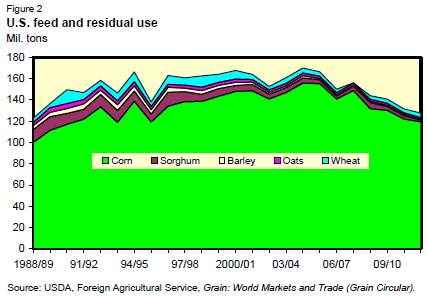
Feed Use
On a September-August marketing year basis for 2011/12, US feed and residual use for the four feed grains plus wheat is projected to total 128.3 million tons, down 1.5 million from the revised total of 129.8 million tons in 2010/11. Corn is estimated to account for 93 per cent of feed and residual use in 2011/12, down from 94 per cent in 2010/11.
The projected index of grain-consuming animal units (GCAU) in 2011/12 is 94.2 million units, up from 92.9 million in 2010/11. Feed and residual per GCAU in 2011/12 is estimated at 1.36 tons, down from 1.40 in 2010/11. In the index components, GCAUs are increased for beef, dairy, pork, and poultry.
USDAs 19 September Milk Production report indicated milk production in the 23 major producing States during August totaled 15.3 billion pounds, up 2.2 per cent from August 2010. Production per cow averaged 1,810 pounds for August, 18 pounds above last year. However, the number of milk cows on farms increased by 102,000 head from August 2009 to 8.47 million. The milk production forecast for 2011 is raised as the dairy herd has been expanding at a more rapid rate and milk per cow during the summer increased more rapidly than expected. However, the forecast for 2012 is reduced as forecast lower milk prices and weakening milk-feed ratios increase the pace of later-year declines in cow numbers.
US hog breeding inventory in the third quarter of 2011 was at 5.81 million head, up one per cent from last year and up slightly from the previous quarter according to USDAs 28 September Quarterly Hogs and Pigs report. Market hogs inventory, at 66.6 million head, was up one per cent from last year. As the result of lower market inventory, lower slaughter, and slower growth in slaughter weights, the 2011 pork production forecast is reduced. Intended farrowings from December 2011 to February 2012, at 2.87 million sows, are down slightly from the same period a year earlier but up slightly from December 2009-February 2010 based on the report. Pork production for 2012 is raised from last month as increased pigs per litter support a larger pig crop and increased supplies of slaughter hogs into 2012 despite steady numbers of sows farrowing.
USDAs Broiler Hatchery report on 7 October indicated that broiler-type egg sets and chicks placed have been decreasing. Cumulative placements of broiler flock are down seven per cent from the same period a year earlier. Broiler production is reduced as lower egg sets point to a sharp reduction in later-year bird slaughter. However, continued relatively heavy bird weights result in an increase in expected thirdquarter production. Table egg production is increased but is partly offset by lower expected broiler hatching egg production.
Egg-type chicks hatched and pullet chicks for future hatchery supply have been increasing based on USDAs 22 September Chickens and Eggs report. Table egg production is increased.
USDAs 15 September Turkey Hatchery report indicated that during August 2011, turkey poults hatched were up four per cent from the year earlier, but net poults placed were 100,000 below August 2010. The 2011 turkey production projection is 15 million pounds higher than last months, but the turkey meat forecast for 2012 is unchanged from last month as lower feed prices stabilize turkey production.
USDAs 23 September Cattle on Feed report indicated that placements and marketings of feed cattle during August both increased five per cent above a year earlier. The increase in beef production is largely due to higher expected cow slaughter as drought conditions in much of the Southern Plains and high hay prices will likely keep slaughter high.
Minor Changes Made to 2010/11 Crop Year
The following changes are made to the 2010/11 balance sheets:
Corn: feed and residual use is lowered 197 million bushels to 4,803 million this month based on 1 September stocks; food, seed, and industrial (FSI) use is lowered 15 million bushels to 6,415 million, reflecting lower-than-expected fourth quarter HFCS consumption due to reduced demand for soft drinks and small decreases in some other FSI uses; corn exports are unchanged from September at 1,835 million bushels; ending stocks are raised 208 million bushels to 1,128 million bushels, based on the 1 September stocks estimate. The farm price per bushel was lowered $0.02 per bushel to $5.18.
Sorghum: feed and residual is lowered 0.8 million bushels to 124.2 million due to reduced ending stocks of 27.5 million, based on the 1 September stocks estimate; and the farm price per bushel was lowered $0.13 to $5.02.
Barley: feed and residual use was raised slightly to 49.8 million bushels due to lower ending stocks.
Oats: feed and residual use was lowered slightly to 102.2 million bushels on a 24,000-bushel increase in ending stocks.
2011/12 Corn Crop Slips on Lower Harvested Acreage, Yields Steady
US corn production is forecast at 12,433 million bushels for 2011/12, down 64 million bushels from last month. Yields are unchanged and forecast harvested acreage was reduced 452,000 acres to 83.9 million. As forecast, this years production would be the fourth highest on record behind 2009, 2007, and 2010. Beginning stocks are raised to 1,128 million bushels, up 208 million from last month based on reported 1 September stocks.
The 1 October corn objective yield data indicate the second highest number of ears per acre on record for the combined 10 objective yield States (Illinois, Indiana, Iowa, Kansas, Minnesota, Missouri, Nebraska, Ohio, South Dakota, and Wisconsin), only behind the record year of 2009. Record-high ear counts are forecast in Iowa, Illinois, Ohio, and Wisconsin.
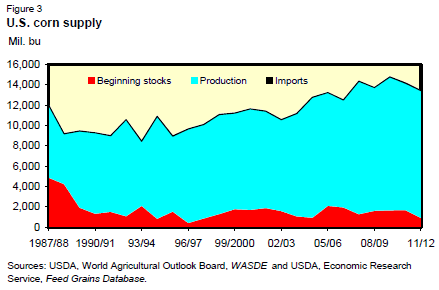
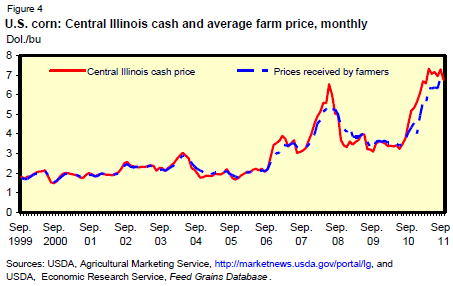
Feed and residual use is unchanged at 4,700 million bushels, reflecting the effects of relatively high corn prices. Exports are lowered 50 million bushels to 1,600 million as a result of increased export competition, especially from the Ukraine. Corn used for ethanol production in 2011/12 was unchanged this month at 5,000 million bushels, based on anticipated fuel demand. Total utilization is projected at 12,710 million bushels, down 50 million from last month and 343 million below 2010/11.
Ending stocks are raised sharply this month by 194 million bushels. Nevertheless, at a projected 866 million bushels, 2011/12 ending stocks would be the lowest since 1995/96 (426 million bushels). Projected stocks drop to less than 25 days of expected use. Increased supplies due to higher carryin result in lower expected corn prices, with the 2011/12 forecast price reduced 30 cents on both ends of the range to $6.20-$7.20 per bushel. These price forecasts are still far above the record 2010/11 actual price of $5.18 per bushel.
Sorghum Production Cut
US production is forecast at 244 million bushels, down 294,000 bushels from last month and 101 million below last year. Based on updated administrative information, acreage changes were made in several States. Planted area is estimated at 5.5 million acres, up 122,000 acres from the previous forecast and up 63,000 from 2010/11. Harvested area is forecast at 4.4 million acres, down 44,000 acres from the previous forecast and 376,000 acres below last year. If realised, this will be the lowest harvested acreage on record since 1936. Based on 1 October conditions, yield is forecast at 55.0 bushels per acre, down 0.6 bushels from September and down 16.8 bushels from last year. Sustained hot weather and drought has affected major producing regions. With a one million bushel increase in beginning stocks, total supply for 2011/12 is projected at 271 million bushels, down 491,000 from last month, reflecting increased carryin partly offset by lower production.
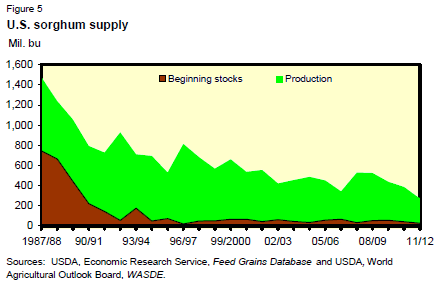
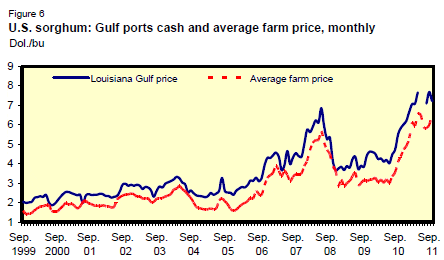
Projected total utilization is 245 million bushels, unchanged from last month and down 114 million from 2010/11. Feed and residual use is expected to be 10 million bushels higher this month and forecast export demand slips 10 million bushes as the pace of export sales has been slow. Exports are expected to total 100 million bushels, down from 150 million in 2011/12. Ending stocks for 2011/12 were raised 0.5 million bushels this month to 26 million.
The expected sorghum season-average price was lowered $0.30 on both ends of the range to $6.00-$7.00 per bushel, compared to the revised $5.02 per bushel for 2010/11. This sharp year-to-year increase in expected price reflects the smaller corn and sorghum crops and tighter feed grain supplies.
Barley Crop Lowered
US barley production for 2011/12 is forecast at 155 million bushels, down 13 million from August and down 25 million from 2010/11. Average yield per acre, at 69.2 bushels, is down 1.2 from last month and 3.9 bushels from last year. Area harvested for grain is estimated at 2.2 million acres, 151,000 below last month and 226,000 below 2010/11. Total supply of barley is projected at 254 million bushels, down 13 million from last month and down 51 million from 2010/11. Imports were unchanged from last months projection of 10 million bushels.
Projected barley use is lowered 10 million bushels from last month due to reduced feed and residual. Ending stocks for 2011/12 are lowered by three million bushels to 54 million and are down 35 million from last year. Barley prices were reduced by 15 cents on the low end or the range and 25 cents on the high end of the range to $5.30-$6.30 per bushel, compared with $3.86 in 2010/11. Higher expected prices year-to-year reflect stronger feed grain prices generally and steady malting barley demand.
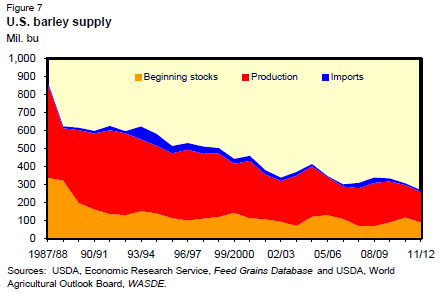
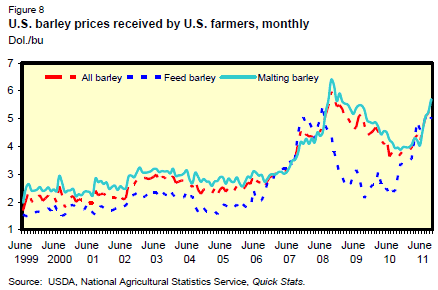
Oats Production Continues to Set Record Lows
US production of oats for 2011/12 is estimated at a record low 54 million bushels, down three million bushels from last month and down 27 million from 2010/11. The estimated yield was lowered 4.1 bushels per acre from last month to 57.5 bushels. Compared with last year, yields were down 6.8 bushels per acre. Area planted to oats is estimated at 2.5 million acres, down slightly from last month and 642,000 acres lower than for 2010/11. The largest declines occurred in North Dakota, Wisconsin, Minnesota, South Dakota, and Iowa, where planted area decreased 110,000, 100,000, 80,000, 70,000, and 60,000 acres, respectively. Harvested area, estimated at 940,000 acres, is up slightly from last month but down 323,000 acres from last year, making it the smallest acreage harvested for grain on record.
Total oats supply is forecast at 212 million bushels, down three million bushels from last month and 35 million below 2010/11. Projected ending stocks were lowered by three million bushels this month to 43 million bushels, down 25 million from the slightly revised 2010/11 carryout of 68 million. Prices for 2011/12 are lowered 30 cents on both ends of the range to $3.10 to $3.70 per bushel, compared with $2.52 last year.
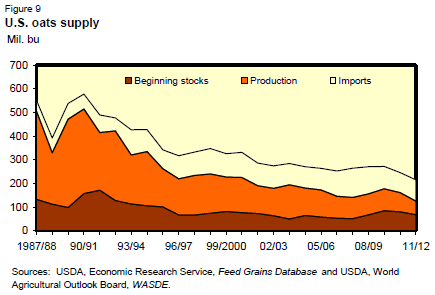

Hay Production Falls in 2011/12
US all-hay production in 2011/12 is forecast at 131.7 million tons, down from 145.6 million tons in 2010/11. Both area harvested and yields are reduced. Total hay harvested area for 2011/12 decreased to 57.6 million acres from 59.9 million last year. Roughage-consuming animal units (RCAU) in 2011/12 are projected to be 68.0 million units, down from 69.2 million in 2010/11. With hay production and RCAUs down, hay supply per RCAU is 1.94 tons in 2011/12, compared with 2.10 tons in 2010/11.
Production of alfalfa hay and alfalfa mixtures is forecast at 64.7 million tons, down slightly from the August forecast and down 3.2 million tons from last year. Based on 1 October conditions, yields are expected to average 3.35 tons per acre, down 0.01 tons from August and down 0.05 tons from 2010. Harvested area is forecast at 19.3 million acres, unchanged from August but down three per cent from the previous year's acreage.
Other hay production is forecast at 67.0 million tons, down slightly from the August forecast, but 14 per cent below 2010/11. Based on 1 October conditions, yields are expected to average 1.75 tons per acre, unchanged from the August forecast and down 0.20 tons from last year. Harvested area, at 38.3 million acres, is unchanged from August but down 4 per cent from the previous year.
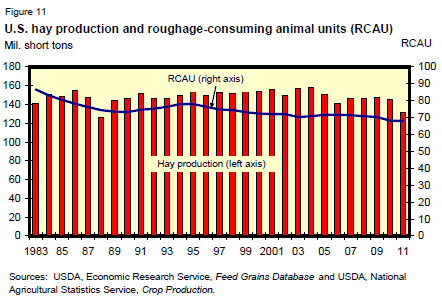
INTERNATIONAL OUTLOOK
Global Coarse Grain Production Increased This Month
World coarse grain production in 2011/12 is projected to reach 1,136.3 million tons, up 5.1 million this month as foreign increases swamped the US decline. Foreign coarse grain production is forecast up 7.1 million tons to 810.0 million, with almost all the change in corn. Foreign barley production is up 0.3 million tons, but sorghum and oats together are down by a like amount.
Corn production for China in 2011/12 is increased 4.0 million tons to 182 million as yields are increased. Rains and temperatures throughout the growing season were exceptionally favorable in the main surplus producing region, the North-East. In the North China Plain, another major growing area, rains were irregular, but the wide availability of irrigation helped limit loses. With most of the harvest finished, yields are reported better than the previous year, and almost as good as the banner year of 2008/09. After a detailed review of provincial yield data, USDA has decided that the official Chinese Government statistics for yields for 2009/10 and 2010/11 are the best available and has adopted those numbers. This increases 2009/10 corn production from 158.0 million tons to 164.0 million, and 2010/11 production from 173.0 million tons, to 177.2 million.
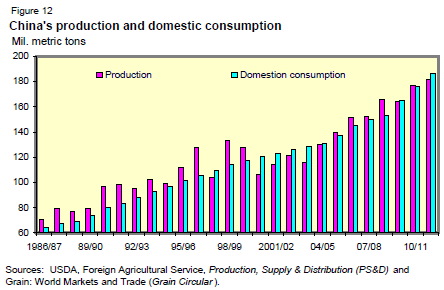
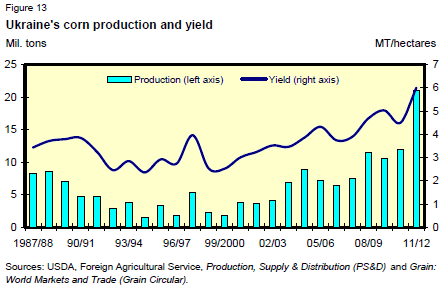
Ukraines corn production for 2011/12 is increased 3.0 million tons this month to a record 21.0 million. With harvest more than a third complete, record yields appear to be a foregone conclusion as the early-harvested areas tend to be lower yielding than the late-harvested areas. The growing season was quite favorable, with some dryness at planting, followed by good rains during the growth cycle, a break in the heat during tasseling (reproduction), and mostly dry conditions for harvest. Corn planted area in Ukraine is the highest since 1963.
Russias corn crop is increased 0.5 million tons to 6.0 million based on improved yields. In the key Southern District, rainfall and temperatures were mostly favorable throughout the growing season. Preliminary harvest reports confirm the higher yield prospects.
Partly offsetting are declines in corn production for Serbia, down 0.3 million tons to 6.7 million tons as dryness during the filling stage reduced yield prospects; for the Philippines, down 0.1 million to 7.0 million, on early indications of crop damage from recent storms; and the EU, down slightly with a reduction for Hungary mostly offset by an increase for Germany.
While world barley production only increased a small amount, several offsetting changes were significant. Russias barley production increased 1.0 million tons to 16.5 million as harvest reports indicate better-than-expected yields. Good yields are also reported in Kazakhstan, boosting production 0.2 million tons to 2.3 million. In Argentina increased area is reported planted to barley as producers seek an alternative to wheat, where government policies interfere with exports. Argentine production is increased 0.2 million tons to 3.3 million. However, in Australia prospects for barley yields are reduced, cutting projected production 0.8 million tons to 8.2 million. Also, government surveys in Canada revealed slightly lower area and yield for barley, cutting production 0.4 million tons to 7.9 million.
Global coarse grain beginning stocks for 2011/12 are up 5.3 million tons this month, with almost the entire change in the United States. Foreign changes were small and mostly offsetting. Increased US beginning stocks and increased foreign production combine to boost world coarse grain supplies 10.4 million tons this month.
Increased Use Forecast Mostly in China
Global coarse grain use is up 4.3 million tons this month to 1,148.5 million. Most of the increase, 4.0 million tons, is for corn used as feed in China. The increases in Chinas corn production for 2009/10, 2010/11, and 2011/12 were balanced by increases in feed and residual use, leaving ending stocks nearly unchanged. South Koreas corn feed use is up 0.5 million tons this month as pork production is recovering from disease related problems. Ukraine, with a record crop, has corn use up 0.35 million tons, with 0.30 million of the increase in feed and residual use. Peru had a small increase in corn use, but Taiwan and Serbia had declines. For Egypt, total corn use is unchanged, but 0.2 million tons are shifted from feed and residual to food and industrial use as more corn is being mixed into wheat flour to make bread.
World barley use forecast for 2011/12 is down 0.9 million tons this month to 136.2 million. All the reductions are in feed and residual use. EU use is down as favorable prices for exports are expected to move barley away from the domestic feed market. With reduced production, feed use in the United States and Canada is cut 0.2 million tons each. Reduced EU barley feed use supports a partly offsetting 0.3-million-ton increase in oats feed use, the only significant change in global oats use this month. Tighter supplies of sorghum are expected to reduce feed use 0.2 million tons each for Mexico and Argentina, partly offset by a similar sized increase in US consumption.
World Coarse Grain Ending Stocks Boosted
Global coarse grain ending stocks for 2011/12 are increased 6.0 million tons this month to 156.0 million. While most of the increase is in US corn stocks, foreign coarse grain stocks are up 1.2 million tons to 131.5 million. Most of the increase in foreign stocks is for corn, up 0.9 million tons to 101.2 million.
Corn stocks prospects for Ukraine are up 0.7 million tons to 2.3 million due to record production. Increased production boosts Russias corn ending stocks 0.3 million tons. Adjustments to Canadas corn trade for 2010/11 boost 2011/12 beginning and ending stocks 0.1 million tons. These increases are partly offset by reductions in ending stocks prospects for Serbia, down 0.1 million tons due to reduced production, with smaller reductions for China, the EU, and Peru.
World barley ending stocks are up 0.9 million tons this month to 22.5 million. Russia and Kazakhstan, with increased production, are raised 0.8 million tons and 0.2 million tons, respectively. However, Australia, with reduced production, has barley ending stocks prospects trimmed 0.1 million tons. Australia, with reduced sorghum production, has ending stocks prospects reduced 0.2 million tons, accounting for most of the change in projected global sorghum stocks. EU oats stocks are reduced 0.3 million tons this month, accounting for most of the change in global oats stocks. EU rye stocks are projected down 0.1 million tons.
World Corn Trade Increased, US Export Prospects Reduced
Global corn trade for 2011/12 (October-September) is projected up 1.2 million tons this month to 93.3 million. Increased exportable supplies and some moderation in prices are encouraging trade prospects. South Koreas corn imports are increased 0.5 million tons to 7.7 million based on strong recent purchases and the recovery of the pork sector from disease problems. Corn import for Peru and the Philippines for 2011/12 are each boosted 0.1 million tons this month. Slightly reduced production prospects (2010/11 for Peru and 2011/12 for Philippines) support import prospects. However, Taiwans corn imports have lagged, and prospects for 2011/12 are reduced 0.2 million this month.
Ukraine, with a record corn crop, is projected to export 12.0 million tons of corn in 2011/12, up 2.0 million this month and more than double the 5.0 million estimated for 2010/11. Of all export competitors, Ukraine has responded to increased corn prices with the largest increase in corn production and exports. Russia, with increased production, is expected to export 0.6 million tons, double last months forecast, but still less than half the corn exported in 2008/09. Serbias corn export prospects are trimmed 0.1 million tons to 2.1 million due to reduced production prospects.
US export prospects for 2011/12 are reduced 1.0 million tons to 41.0 million (down 50 million bushels to 1.6 billion for the September-August local marketing year). Reduced production, high prices, and increased competition are putting a damper on US corn export prospects. However, as of 29 September 2011, outstanding sales of corn reached 14.3 million tons, up from 13.8 million a year earlier.
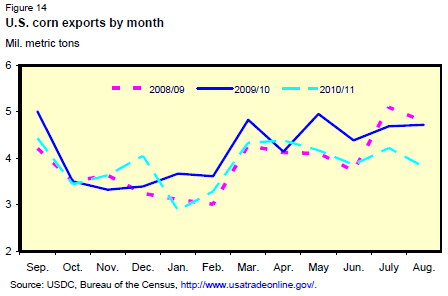
The slow pace of US corn exports in September 2011 (inspections of 2.9 million tons, compared to 4.3 million a year earlier) caused a reduction of 0.5 million tons to 45.5 million for the 2010/11trade year export estimate.
US sorghum export prospects for 2011/12 are reduced 0.2 million tons to 2.7 million (down 10 million bushels for the local marketing year to 100 million). Tight sorghum supplies and competition from domestic demand are expected to limit exports. Mexicos sorghum imports are reduced 0.2 million tons to 2.1 million due to tight US supplies.
World barley trade in 2011/12 is projected at 15.4 million tons, unchanged this month. While projections for importers did not change, a number of offsetting changes were made in export prospects. With reduced production, Australias exports are reduced 0.7 million tons to 4.0 million and Canadas export prospects are trimmed 0.2 million tons to 0.7 million. However, EU exports are raised 0.5 million tons to 2.0 million and exports by Argentina and Russia are each boosted 0.2 million.


